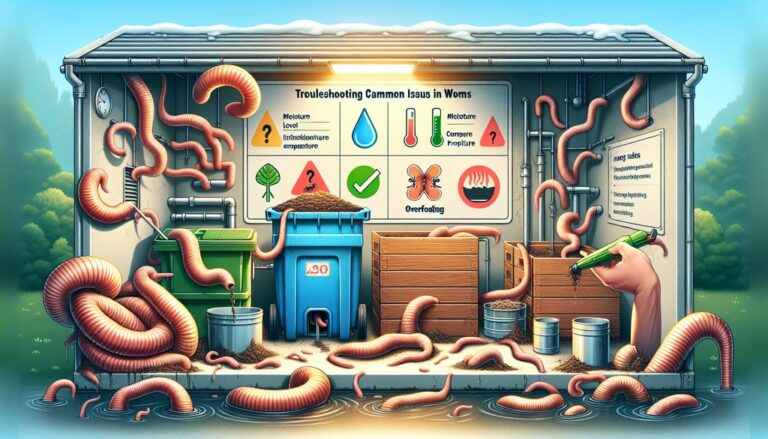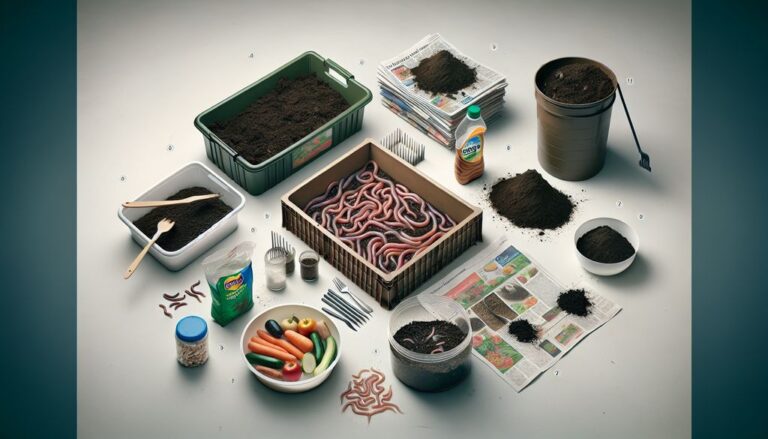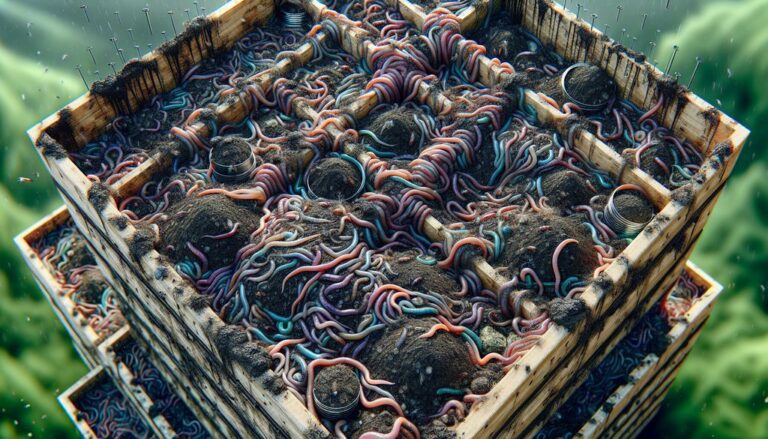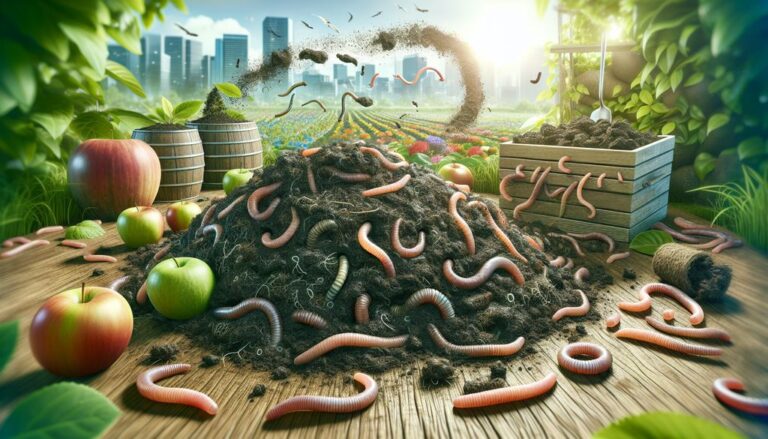Maintaining the right moisture content in your worm bin is crucial for the success of vermicomposting. Proper moisture levels support the decomposition process and the well-being of your worm population. In this article, we will explore the best practices for balancing moisture in your worm bin, along with key takeaways to help you maintain a healthy and productive vermicomposting system.
Key Takeaways
- Monitor moisture regularly to ensure it resembles a damp sponge.
- Avoid excessive moisture to prevent anaerobic conditions.
- Maintain temperatures between 55°F to 77°F for optimal worm health.
- Balancing compost materials is essential for efficient decomposition.
- Proper maintenance of the worm bin is crucial for successful vermicomposting.
Maintaining Moisture in Your Worm Bin
Balancing Moisture Levels
Achieving the right moisture balance in your worm bin is essential for the health of your worms and the quality of your compost. The compost should feel like a damp sponge, neither too wet nor too dry. To maintain this balance, consider the following steps:
- Monitor the moisture regularly by feeling the compost with your hands. It should be moist to the touch, but not dripping water.
- If the compost is too dry, add water sparingly. Use a spray bottle to mist the surface or pour small amounts of water evenly over the compost.
- For excess moisture, add dry materials such as straw or shredded paper to absorb the excess and restore balance.
Maintaining the right moisture level is a continuous process that requires regular attention. Adjustments should be made gradually to avoid shocking the worms and disrupting the composting process.
Remember, the goal is to create an environment where microorganisms can thrive and efficiently break down organic matter. By keeping a close eye on moisture levels and making small, consistent adjustments, you can ensure a successful and odor-free composting experience.
Monitoring Moisture Regularly
Regular monitoring of moisture levels in your worm bin is essential to maintain the delicate balance required for optimal composting conditions. The compost should feel like a damp sponge, neither too wet nor too dry. This consistency is crucial for supporting the microorganisms that break down organic matter effectively.
To ensure that your worm bin has the right moisture level, follow these simple steps:
- Check the moisture level periodically by feeling the compost with your hands.
- If the compost feels dry, lightly sprinkle water over it to achieve the desired moisture.
- Conversely, if the compost is too wet, add dry brown materials like straw or shredded paper to absorb the excess moisture.
Maintaining the right moisture level is a balancing act that requires regular attention. It’s a key factor in creating a thriving environment for your worms and ensuring the efficient breakdown of organic waste.
Remember, if the bin is too dry, the decomposition process will slow down, and if it’s too wet, it can lead to unpleasant odors. By monitoring and adjusting the moisture regularly, you can keep your worm bin in top condition.
Avoiding Excessive Moisture
To prevent the common issue of excessive moisture in your worm bin, which can lead to anaerobic conditions and unpleasant odors, it’s important to take proactive steps. Incorporate dry brown materials such as straw or shredded paper to absorb any excess moisture. These materials not only help to balance the moisture levels but also add carbon to your compost, which is essential for a healthy composting process.
Ensuring your worm bin has adequate aeration is also crucial. This facilitates evaporation and helps maintain balanced moisture levels. Without proper aeration, your bin is at risk of becoming too wet, which can harm the worms and slow down the decomposition process.
Here are some additional tips to avoid excessive moisture:
- Regularly check the moisture level of your compost to ensure it remains within the optimal range.
- If the bin is too wet, add more bedding or dry materials to soak up the excess moisture.
- Avoid overwatering and be mindful of the natural moisture content of the food scraps you add.
- Ensure your bin has proper drainage to allow any excess water to escape.
Harvesting Worm Castings
Separating Worms from Compost
Once your worm bin has transformed kitchen scraps into rich, organic matter, it’s time to harvest the worm castings. The key to efficient harvesting is separating the worms from the compost without harming the worms or disrupting the ecosystem you’ve created. One effective method is the ‘divide and conquer’ approach, where you gradually move the food source to one side of the bin, encouraging the worms to follow, leaving the castings behind.
To ensure a smooth separation process, patience is essential. Allow the worms ample time to migrate towards the food, which can take a few days.
Another popular technique is the use of a ‘worm tower’ or separate trays. As the worms finish composting the top layer, they naturally move down to the next tray, making it easier to collect the castings from the upper layer. Here’s a simple step-by-step guide:
- Stop adding new scraps to the bin for a short period.
- Introduce fresh bedding and food to the bottom tray.
- Wait for the worms to migrate downwards.
- Harvest the castings from the top tray.
Remember, the goal is to create a stress-free environment for the worms while efficiently collecting your compost. Regular monitoring and gentle handling will ensure a successful harvest.
Proper Screening Techniques
After mastering proper screening techniques, the next crucial step is to ensure that the worm castings you harvest are pure and free from contaminants. Pure castings are vital for the health of your plants and the quality of your soil.
To achieve this, follow these simple steps:
- Inspect the castings for any remaining debris or unprocessed material and remove them.
- Sift the castings through a fine mesh to separate any small particles or immature worms.
- Store the castings in a clean, dry area to prevent contamination from pests or molds.
Remember, the purity of your worm castings directly impacts their effectiveness as a soil amendment. Taking the time to ensure cleanliness will pay off in the health of your garden.
By adhering to these practices, you can confidently use your worm castings, knowing they will provide the best possible nutrients for your plants. Regularly maintaining the purity of your castings will also help in monitoring the overall health and efficiency of your worm bin system.
Ensuring Pure Castings
After ensuring you have pure worm castings, it’s crucial to integrate them into your garden soil effectively. Worm castings are a potent organic fertilizer, rich in nutrients and beneficial microorganisms that promote plant growth and soil health. To make the most of your castings, consider the following tips:
- Gradually mix castings into your potting soil or garden beds to provide a steady supply of nutrients.
- Use castings as a top dressing for plants to give them a quick nutrient boost.
- Brew worm tea by soaking castings in water, which can then be used as a liquid fertilizer for both foliage and roots.
By incorporating worm castings into your soil, you’re not only feeding your plants but also enhancing the soil’s structure and moisture retention capabilities. This leads to stronger root systems and healthier plants overall.
Remember, while worm castings are incredibly beneficial, balance is key. Avoid using them in excess, as too much of any amendment can disrupt the delicate ecosystem of your soil. Start with small amounts and observe how your plants respond before increasing the quantity.
Maintaining Your Compost Bin
Proper Maintenance
Maintaining your worm bin is crucial for the health of your worms and the quality of your compost. Regular inspection and cleaning are key to preventing issues such as mold growth and pest infestations. Ensure that the bin is kept in a location with stable temperature and away from direct sunlight to avoid overheating.
- Check the bin weekly for excess moisture and remove any standing water.
- Stir the compost gently to allow air circulation and prevent compaction.
- Replace bedding materials as needed to maintain a comfortable environment for the worms.
By dedicating a small amount of time each week to these tasks, you can keep your worm bin thriving and productive for years to come.
Balancing Compost Materials
Achieving the right balance between green and brown materials in your compost bin is essential for efficient decomposition. Green materials, such as fruit and vegetable scraps, coffee grounds, and grass clippings, provide nitrogen. Brown materials, like dry leaves, straw, and paper, contribute carbon. A roughly equal ratio of these components is ideal for maintaining a healthy composting process.
To prevent common issues such as unpleasant odors or slow decomposition, it’s important to monitor and adjust the balance of materials regularly.
Here are some tips to help you maintain this balance:
- Add more brown materials if the compost is too wet or smells foul.
- Incorporate more green materials if the compost seems too dry.
- Regularly turn the compost to ensure even distribution of materials and aeration.
Remember, a well-balanced compost bin not only promotes efficient decomposition but also helps in reducing the emission of harmful greenhouse gases by diverting organic waste from landfills.
Monitoring Moisture Levels
To maintain a healthy worm bin, monitoring moisture levels is crucial. The compost should have the consistency of a damp sponge, which is ideal for microbial activity without becoming waterlogged. Here are some steps to ensure optimal moisture:
- Check the moisture level periodically by feeling the compost’s texture.
- If the compost feels dry, lightly sprinkle water to achieve the desired moisture.
- In case of excess wetness, add dry brown materials like straw or leaves to absorb the extra moisture.
Maintaining the right moisture balance is essential for the composting process and the health of your worms. It prevents odors and ensures efficient decomposition.
Remember, the goal is to create an environment where microorganisms can thrive and break down organic matter effectively. By regularly monitoring and adjusting the moisture levels, you can maintain a thriving worm bin.
Conclusion
In conclusion, maintaining the right moisture content, temperature, and airflow in your worm bin is essential for successful vermicomposting. By balancing moisture levels, monitoring temperature, and adjusting airflow, you can create an optimal environment for the worms to thrive and efficiently break down organic waste. Remember to avoid overwatering, maintain proper insulation, and monitor moisture regularly to ensure the well-being of your worm farm. With these best practices, you can create nutrient-rich compost and contribute to sustainable waste management in your own home.
Frequently Asked Questions
How do I maintain the right moisture content in my worm farm?
Maintaining the right moisture content in the worm farm is essential. The bedding should be damp but not waterlogged. Monitor the moisture regularly by squeezing the bedding – it should release a few droplets of water. If the bedding is too dry, mist it with water, or if it’s too wet, add dry bedding materials. Worms need water but you must not overdo it.
What temperature range do worms prefer in a worm farm?
Worms prefer a temperature range between 55°F to 77°F (13°C to 25°C). Keep the worm farm in a shaded area or provide insulation during extreme weather conditions.
How do I harvest worm castings?
Harvesting worm castings can be done by separating the worms from the compost. Proper screening techniques should be used to ensure pure castings are separated from unfinished materials.
What should I do if my compost bin becomes overly wet?
If your compost bin becomes overly wet, add dry brown materials to absorb the excess moisture and improve aeration. Additionally, ensure that the compost bin’s lid is secure to prevent excessive moisture.
How do I maintain proper moisture levels in my compost bin?
Check the moisture levels within the compost bin. The ideal moisture content should resemble a damp sponge—neither too dry nor waterlogged. Adjust as needed by adding dry materials to absorb excess moisture or lightly watering the compost if it’s too dry.
What should I do if my compost bin develops foul smells?
Unpleasant odors can result from anaerobic conditions within the compost bin. To combat foul smells, increase aeration by turning the compost and introduce dry, absorbent materials to improve airflow and neutralize odors.






